Bacteria pitted against fungi to protect wheat and barley

(Phys.org)—Soil-dwelling bacteria that depend on wheat and barley roots for their "room and board" could soon prove themselves helpful to the plants in return. U.S. Department of Agriculture (USDA) scientists in Pullman, Wash., are investigating the bacteria's potential to biologically control root-rot fungi that cause crop yield losses of 10 to 30 percent annually in the U.S. Pacific Northwest and elsewhere.
The bacteria are members of the genus Pseudomonas and include 11 strains that stymie the growth of Pythium and Rhizoctonia fungi, which cause diseases in wheat and barley crops. The fungi thrive in cool, moist soils and can reach especially high levels in crop fields where conservation tillage is practiced to save on fuel costs, avoid soil erosion, and provide other ecological and environmental benefits.
The two pathogens are most problematic to seedlings of spring crops that are four to six weeks old, notes Pat Okubara, a geneticist in the Agricultural Research Service (ARS) Root Disease and Biological Control Research Unit in Pullman. ARS is USDA's chief intramural scientific research agency.
Fungicides aren't very effective, according to Okubara, and there are no resistant wheat or barley varieties available to growers yet. Rotating wheat with non-host crops is difficult, too, because of the pathogens' extensive plant-host range.
However, the Pseudomonas bacteria can secrete powerful enzymes and biochemicals that can keep these fungal rivals at bay, to the benefit of wheat and other host crops. Some strains of the bacteria also help plants help themselves by triggering a sort of immune-system response called "induced systemic response." Other strains produce hormone-like substances that spur on root and shoot growth in host plants, helping them overcome fungal damage.
In greenhouse tests conducted by Okubara and colleagues, use of five of the Pseudomonas strains diminished the severity of R. solani AG-98 root rot by 30 to 92 percent and P. ultimum by 32 to 56 percent. Two strains also reduced rot caused by R. oryzae and P. irregulare, which plague Pacific Northwest wheat and barley crops. Detailed results appear in the August 2012 issue of Biological Control.
A commercial product isn't likely for another few years. But the arrival of any new antifungal weaponry should be welcome news for wheat growers, especially those who've shied away from direct seeding or other conservation-tillage measures, notes Okubara.
More information: "New Technology for Harvesting the Power of Beneficial Fungi" was published in the January 2013 issue of Agricultural Research magazine. www.ars.usda.gov/is/AR/archive/jan13/fungi0113.htm
Journal information: Agricultural Research
Provided by Agricultural Research Service

















